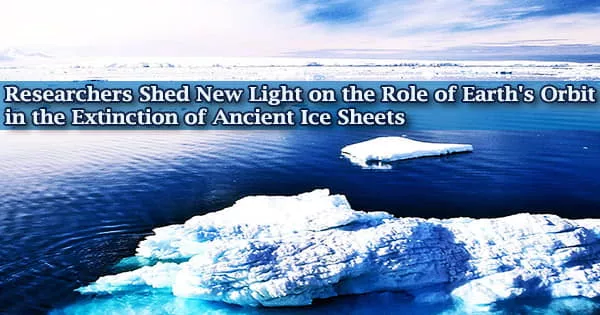Scientists have finally put an end to a long-running debate on the significance of Earth’s orbit in global ice age cycles.
The team from Cardiff University has been able to quantify exactly how the tilting and wobbling of the Earth as it circles around the Sun has affected the melting of ice sheets in the Northern Hemisphere during the past 2 million years in a new study published today in the journal Science.
Scientists have long known that changes in the geometry of Earth’s orbit around the Sun cause enormous Northern Hemisphere ice sheets to wax and wane. According to a revised age reconstruction, the Eurasian Ice Sheet’s marine-based parts melted quickly, contributing to a substantial sea-level rise 14,600 years ago.
The fast disintegration of enormous ice revealed the vulnerability of Earth’s surviving ice sheets. Obliquity and precession are two features of the Earth’s geometry that can influence ice sheet melting.
The angle of the Earth’s tilt as it moves around the Sun is called obliquity, and it is the reason for the seasons. Precession describes how the Earth wobbles as it spins, similar to a spinning top that is slightly off-center.
Because of the angle of this wobble, the Northern Hemisphere is closest to the Sun at times and the Southern Hemisphere is closest at other times, meaning that every 10,000 years or so, one hemisphere will have warmer summers than the other.
An ice sheet is a glacial ice mass that covers more than 50,000 square kilometers (19,000 square miles). Ice sheets, also known as continental glaciers, hold nearly 99 percent of the world’s freshwater. Ice shelves form when ice sheets reach the shore and cross the ocean.
Early Pleistocene ice sheets in the northern hemisphere were smaller than their more recent counterparts, and limited to higher latitudes where the effects of obliquity dominate over precession. This probably explains why it has taken so long for us to find evidence of precession forcing during early Pleistocene.
Professor Stephen Barker
Scientists have determined that the combined effects of obliquity and precession on the waxing and waning of Northern Hemisphere ice sheets over the past million years or so have resulted in ice age cycles lasting approximately 100 thousand years, thanks to complicated interactions within the climate system.
However, prior to 1 million years ago, during the early Pleistocene, the duration of ice age cycles was determined only by obliquity, and these ice age cycles lasted over 41,000 years.
Scientists have been perplexed for decades as to why precession did not play a larger role in driving ice age cycles during this time. The Cardiff University team presents new data in their recent study that suggests precession did play a role throughout the early Pleistocene.
Their findings reveal that more intense summers, driven by precession, have always caused Northern Hemisphere ice sheets to melt, but that these occurrences were less severe and did not result in the entire collapse of ice sheets before 1 million years ago.
Like other glaciers, ice sheets formed. Year after year, snow accumulates and then melts. The slightly melting snow hardens and compresses as it cools. It transforms from a fluffy powder to a block of hard, spherical ice pellets over time.
Lead author of the study Professor Stephen Barker, from Cardiff University’s School of Earth and Environmental Sciences, said:
“Early Pleistocene ice sheets in the northern hemisphere were smaller than their more recent counterparts, and limited to higher latitudes where the effects of obliquity dominate over precession. This probably explains why it has taken so long for us to find evidence of precession forcing during early Pleistocene.”
“These findings are the culmination of a major effort, involving more than 12 years of painstaking work in the laboratory to process nearly 10,000 samples and the development of a range of new analytical approaches. Thanks to this we can finally put to rest a long-standing problem in paleoclimatology and ultimately contribute to a better understanding of Earth’s climate system.”
“Improving our understanding of Earth’s climate dynamics, even in the remote past, is crucial if we hope to predict changes over the next century and beyond. Ongoing changes may be humanmade, but there’s only one climate system and we need to understand it.”
















